ZEN MESTEREK ZEN MASTERS
« Zen főoldal
« vissza a Terebess Online nyitólapjára

Zen school (Zenshū 禪宗)
http://global.sotozen-net.or.jp/eng/library/glossary/individual.html?key=zen_school
Although there is good reason to speak of the "Zen school" as a distinct branch of the Buddhist tradition of Japan, there has never been any organized social or institutional entity bearing that name. At present, there are twenty-two comprehensive religious corporations (hōkatsu shūkyō hōjin 包括宗教法人) registered with the Japanese government that are recognized as belonging to the Zen tradition (Zenkei 禪系). These include: the Soto School (Sōtōshū 曹洞宗); fifteen separate corporations that identify themselves as branches (ha 派) of the Rinzai lineage (Rinzaishū 臨濟宗); the Ōbaku School (Ōbakushū 黃檗宗); and five small corporations that have splintered off from the Soto and Rinzai organizations. Each of the twenty-two Zen denominations has a number of temples affiliated with it, ranging from 14,664 in the Soto School to 3,389 in the Myōshinji branch of the Rinzai lineage (Rinzaishū Myōshinjiha 臨濟宗妙心寺派), 455 in the Ōbaku School, a few hundred in the smaller Rinzai denominations, and just a handful in the smallest of the corporations (all data from Bunkachō 文化廳, ed., Shūkyō nenkan 宗教年鑑, 2003 Edition).
One thing that clergy affiliated with all the Zen denominations in Japan hold in common is the belief in a Zen lineage (Zenshū 禪宗) of dharma transmission said to have been founded by the Buddha Shakamuni, established in China by the Indian monk Bodaidaruma, and subsequently transmitted to Japan by numerous Japanese and Chinese monks. During the Kamakura period (1185-1333) and the two decades immediately following, by one account, some twenty-four separate branches (ryūha 流派) of the Zen lineage were established in Japan. By another reckoning, there were forty–six individual transmissions of the Zen dharma to Japan, beginning with Myōan Eisai 明庵榮西 (1141-1215) in 1191 and extending down to the Chinese monks Ingen (C. Yinyuan 隱元, 1592–1673) and Shinetsu (C. Xinyue 心越, 1639–1696), who came to Japan in 1654 and 1677, respectively, and established the so-called Ōbaku lineage (Ōbakushū 黃檗宗). At present, however, all Zen clergy trace their own lineages of dharma inheritance back to China through only two men:
(1) Nanpo Jōmyō 南浦紹明 (1235-1308), a.k.a. Daiō Kokushi, founder of the Daiō branch (Daiōha 大應派) of Rinzai Zen; and
(2) Dōgen Kigen 道元希玄 (1200-1253), founder of the Dōgen branch (Dōgenha 道元派) of Soto Zen. All the other branches of the Zen lineage that flourished in the past are said to have died out, having failed at some point to produce any more dharma heirs.
Most of the Zen denominations in Japan operate training monasteries in which the bureaucratic structures, ritual calendars, and modes of practice are modeled after those found in the leading Buddhist monasteries of Song (960-1279) and Yuan (1280-1368) dynasty China. Those institutional forms were first imported into Japan in the Kamakura period, chiefly (but not exclusively) by the same monks who transmitted the Zen lineage. Texts containing the religious lore of the Zen lineage in China - genealogies of dharma transmission, biographies of Zen masters, records of their discourses, and koan collections - were also brought to Japan at that time, and have been handed down to the present within the various denominations as the common heritage of the Zen school.
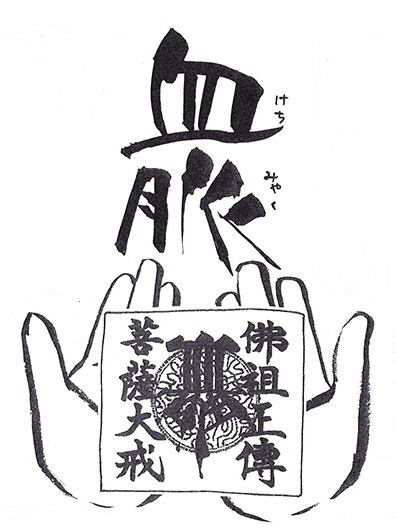
佛祖正傳菩薩大戒血脈
Busso shōden bosatsu daikai kechimyaku
The Bloodline of the Buddha’s and Ancestors’ Transmission of the Great Bodhisattva Precepts
Dōgen's Zen Ancestors Chart
It is worth mentioning that the line gets splitted apart
at Dajian Huineng and join back up at Eihei Dōgen
as the left-hand side is the Rinzai (Linji) line*,
and the right-hand side is the Sōtō (Caodong) line**,
reflecting Dōgen's early teacher Myōzen, as well as Rujing.
* 【黄檗・臨済系 法系】
南嶽懐譲和尚様から
佛樹明全和尚様
** 【曹洞系 法系】
青原行思和尚様から
天童如浄和尚様
Shakamunibutsu (Shākyamuni Buddha, Shijiamouni Fo 釋迦牟尼佛))
The Indian Patriarchs:
1. Makakashō (Mahākāshyapa 摩訶迦葉)
2. Ananda (Ānanda 阿難陀)
3. Shōnawashu (Shanakavāsa/Shānavāsin 商那和修)
4. Ubakikuta (Upagupta 優婆掬多)
5. Daitaka (Dhrtaka/Dhītika 提多迦)
6. Mishaka (Micchaka/Mishaka 彌遮迦)
7. Bashumitsu (Vasumitra 婆須密)
8. Butsudanandai (Buddhanandi 浮陀難提, 佛陀難提)
9. Fudamitta (Buddhamitra 浮陀密多, 佛陀密多)
10. Barishiba (Pārshva 婆栗濕婆, 脅尊者)
11. Funayasha (Puṇyayashas 富那夜奢)
12. Anabotei (Ānabodhi/Ashvaghoṣa 阿那菩提, 馬鳴)
13. Kabimora (Kapimala 迦毘摩羅)
14. Nagyaharajuna (Nāgārjuna 龍樹, 那伽閼樹那)
15. Kanadaiba (Kāṇadeva 迦那提婆 (提婆), 聖天)
16. Ragorata (Rāhulata/Rāhulabhadra 羅睺羅多)
17. Sōgyanandai (Saṃghanandi 僧伽難提)
18. Kayashata (Gayashāta 僧伽舍多)
19. Kumorata (Kumārata/Kumāralāta 鳩摩羅多)
20. Shayata (Jayata/Shayata 闍夜多)
21. Bashubanzu (Vasubandhu 世親, 天親, 婆修盤頭)
22. Manura (Manorata/Manorhita/Manothata 摩拏羅)
23. Kakurokuna (Haklenayashas 鶴勒那)
24. Shishibodai (Aryasimha/Simha Bhikshu/Siṃhabodhi 師子菩提)
25. Bashashita (Basiasita/Vasi Astia 婆舍斯多)
26. Funyomitta (Puṇyamitra 不如密多)
27. Hanyattara (Prajñādhāra/Prajñātāra 般若多羅)
The Chinese Patriarchs:
28/1. Bodaidaruma
(Bodhidharma, Putidamo 菩提 達磨 ?-532/5)
29/2. Taiso Eka
(Dazu Huike 大祖 慧可 487-593)
30/3. Kanchi Sōsan
(Jianzhi Sengcan 鑑智 僧璨 ?-606)
31/4. Daii Dōshin
(Dayi Daoxin 大毉 道信 580-651)
32/5. Daiman Kōnin
(Daman Hongren 大滿 弘忍 601-674)
33/6. Daikan Enō
(Dajian Huineng 大鑑 慧能 638-713)
|
34/7. Nangaku Ejō |
34/7. Seigen Gyōshi |
|
35/8. Baso Dōitsu |
35/8. Sekitō Kisen |
|
36/9. Hyakujō Ekai |
36/9. Yakusan Igen |
|
37/10. Ōbaku Kiun |
37/10. Ungan Donjō |
|
The Linji (Rinzai) Patriarchs:
|
The Caodong (Sōtō) Patriarchs: |
|
38/11. Rinzai Gigen |
38/11. Tōzan Ryōkai |
|
39/12. Kōke Zonshō |
39/12. Ungo Dōyō |
|
40/13. Nan'in Egyō |
40/13. Dōan Dōhi |
|
41/14. Fūketsu Enshō |
41/14. Dōan Kanshi |
|
42/15. Shuzan Shōnen |
42/15. Ryōzan Enkan |
|
43/16. Funyō Zenshō |
43/16. Taiyō Kyōgen |
|
44/17. Tōshi Gisei |
|
|
45/18. Ōryū Enan |
45/18. Fuyō Dōkai |
|
46/19. Kaidō Soshin |
46/19. Tanka Shijun |
|
47/20. Reigen Isei |
47/20. Chōro Seiryō [Shinketsu ~] |
|
48/21. Chōrei Shutaku |
48/21. Tendō Shōkaku [Wanshi ~] |
|
49/22. Muji Kaijin |
49/22. Setchō Chikan |
|
50/23. Mannen Donkan |
50/23. Tendō Nyojō |
51/24. Setsuan Jūkin |
|
|
52/25. Koan Eshō |
|
|
The Japanese Rinzai Patriarchs: |
|
|
53/26/1. Myōan Eisai |
|
|
54/27/2. Ryōnen Myōzen |
|
The Japanese Sōtō Patriarchs:
51/24/1. [Eihei] Dōgen Kigen
([永平] 希玄 道元 1200-1253)
52/25/2. Koun Ejō
(孤雲 懐奘 1198-1280)
53/26/3. Tettsū Gikai
(徹通 義介 1219-1309)
54/27/4. Keizan Jōkin
(螢山 紹瑾 1268-1325)
|
55/28/5. Gasan Jōseki |
55/28/5. Meihō Sotetsu |
Each priest of the Sōtō school today belongs to an uninterrupted line
which traces itself either to 峨山韶碩 Gasan Jōseki zenji
or to 明峰素哲 Meihō Sotetsu zenji, two disciples of Keizan zenji,
all other Japanese lines having since become extinct.
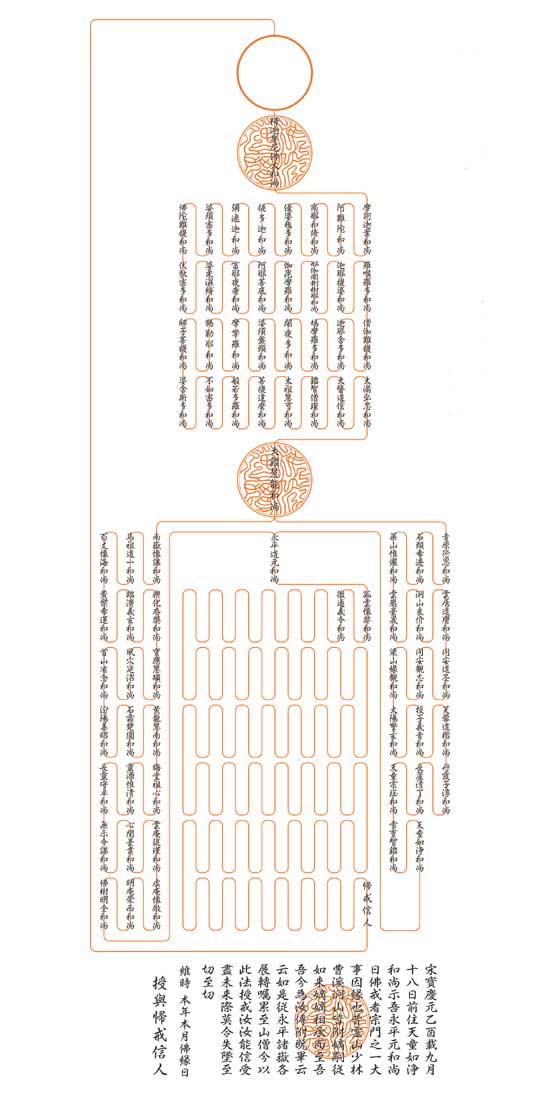
Pre-printed kechimyaku
https://www.tera-mura.co.jp/ketimyaku.htm
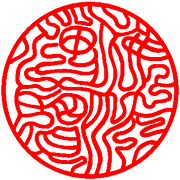
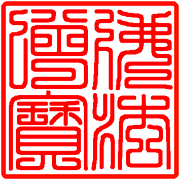
三宝印 sambō-in (佛法僧寶印 Three Treasures seal)
(Reading up to down, R to L)
3 1
4 2
“佛法僧寶”
1.Buddha 佛
2.Dharma 法
3.Sangha 僧
4.Treasure 寶
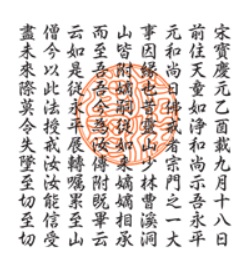
宋寶慶元乙酉戟九月十八日前
住天童如净和尚示吾永平元和
尚日佛戒者宗門之一大事因
緣也昔靈山少林曹溪洞山
皆附嫡嗣從如來嫡嫡相承
而至吾吾今為汝傳附既畢
云云如是從永平展轉嘱累
至山僧今以此法戒授汝汝
能信受盡未來際莫今失墜
至切至切Three approximate English translations:
On the eighteenth day of the ninth month of the first year of the Pao-ching era of the Sung dynasty [宋寶慶 Song Baoqing (1225)], the late abbot of the Tien-tung [天童如净 Tiantong Rujing, 1163–1228] instructed me, Eihei Dōgen oshō [永平道元和尚], saying: “The Buddha Sila are the single most important matter of our school. In the past, the masters of Mount Grdhrakūta [霊鷲山], Shao-lin [少林 Shaolin], Tsao-chi [曹溪 Caoxi], and Mount Tung [洞山 Dongshan] transmitted these Dharma Sila of the Tathāgata [如來] to their successors generation after generation until they came to me." Now I transmit them to you. You should receive them in deep faith and not permit them to be discontinued. For this I earnestly pray.”
*
On the eighteenth day of the ninth month in the first year of Pao-ch'ing of the Great Sung, the Former Abbot T'ien-t'ung Ju-ching instructed: the Precepts of the Buddha are the vital matters of the School. They were transmitted at Gṛdhrakūṭa Mountain, Shao-lin [Monastery], Ts'ao-ch'i and Tung Mountain. It was transmitted from the Tathāgata down through me. Now, I bestow this upon my disciple, Dōgen, a monk from Japan. Here culminates my transmission.
(Takashi James Kodera translation from Dogen's Formative Years in China, Prajñā Press, Boulder, 1980, p. 65)*
On the eighteenth day of the ninth month of the first year of the Baoqing era of the Song dynasty (1225), the late master Tiantong Rujing (1163–1228) instructed me, Eihei Dōgen oshō saying: “Buddha-precept is the single-great-matter of causes and conditions in the lineage-gate. In ancient times, through Shakyamuni Buddha at Vulture Peak, Bodhidharma at Shaolin temple, Huineng at Caoxi mountain, Liangjie of Mt. Dongshan, these precepts of the Tathāgata have been transmitted from a legitimate teacher to a legitimate disciple and have reached to me. Now I entrust them to you. You should protect and keep them. Do not let them be lost or cast down. From the bottom of my heart I entreat you.”
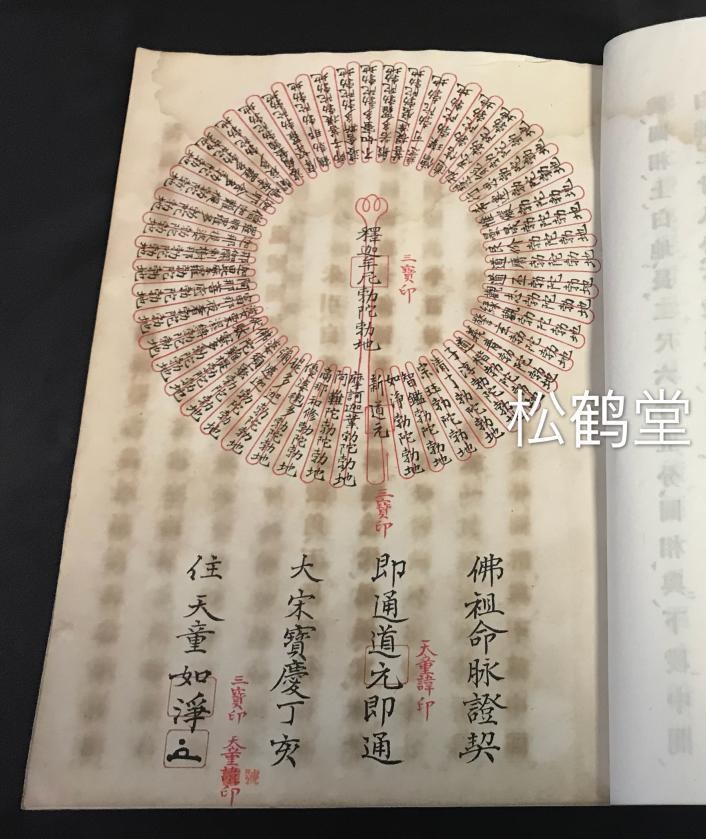
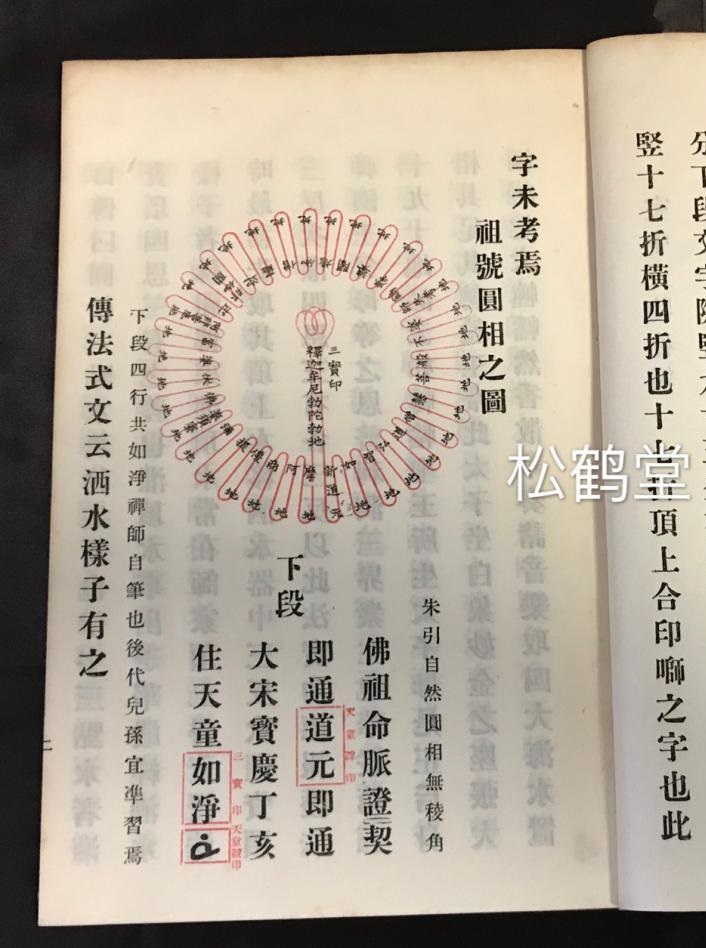
DOC: Dogen's Certificate of Succession: A National Treasure
by Hyatt Carter
Gabor Terebess's Zen Lineage Chart
(in his master's own handwriting,
on silk)
Edit and print your own kechimyaku (Online generator in Japanese)
http://kosoft.on.coocan.jp/danka/manual/ketimyaku.htm
The Two Main Lineages of Modern Sōtō
https://authority.dila.edu.tw/person/
http://www.eonet.ne.jp/~ekakusan/ > http://www.eonet.ne.jp/~ekakusan/houkei.html
http://en.wikipedia.org/wiki/Zen_lineage_charts
https://de.wikipedia.org/wiki/Liste_buddhistischer_Patriarchen
http://pl.wikipedia.org/wiki/S%C5%8Dt%C5%8D
http://www.treeleaf.org/forums/showthread.php?7474-Zen-lineage-chart-Chinese-and-Japanese-Zen-ancestors
默照禪/黙照禅 Mokushō-zen (”silent illumination Zen”, ”serene reflection Zen”)
~ 西有 (瑾英) 穆山 Nishiari (Kin'ei) Bokusan (1821-1910) - 3rd abbot of Sōjiji
~~ 丘 (大潤) 宗潭 Oka (Daijun) Sōtan (1860-1921) – 1st abbot of Antaiji
~~~ 丘 (浩潤) 球学 Oka (Kōjun) Kyūgaku (1877-1953) - vice-abbot of Eiheiji
~~~ 沢木 (祖門) 興道 Sawaki (Somon) Kōdō (1880-1965) – 5th abbot of Antaiji
~~~~ 酒井得元 Sakai (Eshū) Tokugen (1912-1996)
~~~~ 成田 (祖伝) 秀夫 Narita (Sōden) Shūyū (1914-2004)
~~~~ 内山 (道融) 興正 Uchiyama (Dōyū) Kōshō (1912-1998) – 6th abbot of Antaiji
~~~~ 弟子丸 (黙堂) 泰仙 Deshimaru (Mokudō) Taisen (1914-1982) - Association Zen Internationale
~~~~ 横山祖道 Yokoyama Sodō, aka 草笛禅師 Kusabue Zenji / "The Leaf-flute Zen Master" (1907-1980)
~~~~ 川瀬玄光 Kawase (Kaigaku) Genkō (1908-1988)
~~~ 橋本恵光 Hashimoto (Rendō) Ekō (1890-1965) – abbot of Zuiōji
~~~~ 楢崎 (大玄) 一光 Narasaki (Daigen) Ikkō (1918-1996) – abbot of Zuiōji; vice-abbot of Eiheiji
~~~~ 片桐 (慈海) 大忍 Katagiri (Jikai) Dainin (1928-1990) - founder of the Minnesota Zen Meditation Center
~~ 岸澤 (眠芳) 惟安 Kishizawa (Minpō) Ian (1865-1955) - 3rd abbot of Antaiji
~~~ 野圦 (白山) 孝純 Noiri (Hakusan) Kōjun (1914-2007) - Kanyō-an, Ouke, Shimada-shi
~~~~ 森山 (寶輪) 大行 Moriyama (Hōrin) Daigyō (1938-2011) – founder of Zuigakuin
~~~~ 釈元祥 Shaku Genshō [=Gábor Terebess, Hungary] (1944-)
~~~~ 佐藤成孝 Satō Jōkō (1953-) – founder of the Chōkai-san International Zendo
~~~ 鈴木 (祥岳) 俊隆 Suzuki (Shōgaku) Shunryū (1904-1971) - founder of the Zen Center of San Francisco
~~~~ 禪達妙融 Zentatsu Myōyū / Zentatsu Richard Baker (1936-)
~~~~ 鈴木 (牛岳) 抱一 Suzuki (Gyūgaku) Hōitsu (1939-) - 林叟院 Rinsō-in; 永平寺単頭 tanto (head of practice) of Eiheiji
~~~ 丹羽 (瑞岳) 廉芳 Niwa (Zuigaku) Rempō (1905-1993) - 77th abbot of Eiheiji
~~~~ 西嶋 愚道 和夫 Nishijima Gudō Wafu (1919-2014)
~~ 秋野 (大忍) 孝道 Akino (Dainin) Kōdō (1858-1934) - 7th abbot of Sōjiji
看話禪/看話禅 Kanna-zen (”introspecting the kōan Zen”, "Zen of contemplating sayings")
~ 原田 (大雲) 祖岳 Harada (Daiun) Sogaku (1871-1961) – abbot of Hosshinji
~~ 安谷 (白雲) 量衡 Yasutani (Hakuun) Ryōkō (1885-1973) - Sanbō Kyōdan
~~~ 山田耕雲 Yamada Kōun (Zenshin) (1907-1989) - Sanbō Kyōdan
~~~~ Robert Baker Aitken (1917-2010), 大龍貯潭暁雲 Dairyū Chōtan Gyōun - founder of the Diamond Sangha (USA)
~~~~ フーゴ・真備・愛宮=ラッサール Enomiya-Lassalle, Hugo Makibi S.J. (1898-1990), 愛雲軒 Aiun-ken
~~~~ 山田 (凌雲) 正道 Yamada (Ryōun) Masamichi (1940-), son of Yamada Kōun
~~~~ 清雲菴 Roselyn Seiun-an Stone (1931-)
~~~~ 輝雲庵 Ana Maria Kiun-an Schlüter Rodés (1935-)
~~~~ 耕雲軒 Willigis Koun-ken Jäger (1925-2020)
~~~ Philip Kapleau (1912-2004) - founder of the Rochester Zen Center
~~~ 前角 (大山) 博雄 Maezumi (Taizan) Hakuyū (1931-1995) - founder of the Zen Center of Los Angeles
~~~~ シャーロン・浄光・ベック Beck, Charlotte Joko (1917-2011)
~~~~ グラスマン徹玄 Glassman, Tetsugen Bernard (Bernie) (1939-) 梅仙徹玄 Baisen Tetsugen
~~~~ ローリ大道 Loori, John Daido (1931-2009)
~~~~ マーゼル玄法 Merzel, Dennis Genpo (1944-) 祖天玄法 Soten Genpō
~~~ 里見妙道 Satomi Myōdō (1896-1978)
~~~ 窪田慈雲 Kubota Jiun (Akira) (1932-)
~~~ Brigitte D'Ortschy (1921-1990), 皎雲庵 道流 智光 大姉 Kōun-An Dōru Chikō Daishi
~~ 飯田 (大顕) 欓隠 Iida (Daiken) Tōin (1863-1937)
~~ 西脇越堂 Nishiwaki Etsudo (1913-?)
~~ 渡邊 (本行) 玄宗 Watanabe (Hongyō) Genshū (1869-1963) - 17th dokuju (successive) abbot of Sōjiji
~~ 伴鐵牛 (祖印) Ban Tetsugyū (Soin) (1910-1996) – Master of Tōshō-ji, Tokyo
~~~ 祖心 Maura (Soshin) O'Halloran (1955-1982)
~~~ 出口鐵城 Deguchi Tetsujo (1951-) – Master of Tōshō-ji, Tokyo
~~ 原田 (大拙) 湛玄 Harada (Daisetsu) Tangen (1924-2018) - Head of Bukkoku-ji, Obama
~~~ 山端 (大道) 法玄 Yamahata (Daidō) Hōgen (1935-2024) - Abbot of Chogenji, Teacher at the Open Way Association, Australia
Sōtō Zen Lineages (Kanji + Rōmaji) PDF
transmitted to the West
Kishizawa rōshi's Dharma Lineage
Harada & Yasutani rōshi's Dharma Lineage PDF
Sawaki & Uchiyama rōshi's Dharma Lineage PDF
Suzuki rōshi's Dharma Lineage PDF
Niwa zenji & Nishijima rōshi's Dharma Lineage PDF
Noiri & Moriyama rōshi's Dharma Lineage PDF
Maezumi rōshi's Dharma Lineage
Yogo rōshi's Dharma Lineage
Ban Tetsugyū rōshi's Dharma Lineage PDF
Morita zenji's Dharma Lineage
Kohō zenji & Kennett rōshi's Dharma Lineage PDF
Aoyama rōshi's Dharma Lineage
Watanabe & Itabashi rōshi's Dharma Lineage
Iwamoto zenji's Dharma Lineage
Katagiri rōshi's Dharma Lineage
Dharma Lineage of Genrō & Fūgai
Dharma Lineage of Menzan
Ryōkan's Dharma Lineage
Dharma Lineage of Tōsui Unkei
Dharma Lineage of Hashimoto Ekō
Dharma Lineage of Narasaki Ikkō
Dharma Lineage of Otogawa Chino
Dharma Lineage of Hata (Meihō) Egyoku
Dharma Lineage of Eido Frances Carney
Dharma Lineage of Yokoyama Gyōkei & Amato Seigaku PDFDharma Lineage of Deshimaru sensei & Niwa zenji PDF > Deshimaru's disciples authorized after his death PDF
Cf.
Tendai lineage
内証仏法相承血脈譜 Naisho buppo sojo ketsumyaku-fu (lit. Record of the secret transmission of heritage of the Buddhist-Truth)Cf.
Rinzai Zen lineages > PDF
逓代伝法佛祖の名号 Teidai Denpō Busso no Myōgō
Chief Abbots (Dokujū) of Sōji-ji 总持寺独住
http://shinden.boo.jp/wiki/%E7%B7%8F%E6%8C%81%E5%AF%BA
(1) Sengai Ekidō 旃崖奕堂 (Morotake 諸嶽, 1805–1879)
(2) Daioka Baisen 大冈楳仙 (Azekami 畔上, 1825–1901)
(3) Bokuzan Kinei 穆山瑾英 (Nishiari 西有, 1821–1910)
(4) Bokugyū Sodō 牧牛素童 (Ishikawa 石川, 1841-1920)
(5) Bokuei Sekizen 穆英石禅 (Arai 新井, 1864-1927)
(6) Genkō Dōzan 玄光道山 (Sugimoto 杉本, 1847-1929)
(7) Dainin Kōdō 大忍孝道 (Akino 秋野, 1858–1934)
(8) Raiju Taion 雷澍泰音 (Kuriyama 栗山, 1860-1937)
(9) Tenyū Dōkai 天祐道海 (Itō 伊藤, 1874-1940)
(10) Hakuryū Tenzan* 白龙天山 (Suzuki 鈴木, 1863-1941)
(11) Katsuryū Zenkai* 活龙禅戒 (Ōmori 大森, 1871-1947)
(12) Gyokudō Rōsen* 玉堂珑仙 (Takashina 高階, 1876–1968)
(13) Hōun Kaiju 宝云界珠 (Fukuyama 福山, 1881-1943)
(14) Jissan Tokuryū 实山笃立 (Kuga 久我, 1861-1943)
(15) Kunzan Gen'i* 训山玄彝 (Sagawa 佐川, 1866-1944)
(16) Sogaku Taizen* 祖学泰禅 (Kumazawa 熊沢, 1873-1968)
(17) Hongyō Genshū 本行玄宗 (Watanabe 渡辺 1869-1963)
(18) Keidō Chisan 莹堂智灿 (Kohō 孤峰, 1879–1967)
(19) Zekkai Shōshun 绝海胜俊 (Iwamoto 岩本, 1891–1979)
(20) Gyōzan Kinnei 形山瑾英 (Otogawa 乙川, 1902-1982)
(21) [Umeda] Shinryū 梅田信隆 (Umeda 梅田, 1906-2000)
(22) Tokudō Hōzui 得道芳髄 (Narita 成田, 1905-1998)
(23) Unkai Kōshū 雲海興宗 (Itabashi 板橋, 1927-2020)
(24) Daitei Kōsen 大鼎晃仙 (Ōmichi 大道, 1917-2011)
(25) Tetsugen Shinzan 徹玄辰三 (Egawa 江川, 1928-2021)
(26) Ishizuki Shūkō 石附周行 (1937-)
* Also Chief Abbot (Kanshu) of Eihei-ji
Chief Abbots (Kanshu) of Eihei-Ji 永平寺贯首
https://eiheizen.jimdo.com/
(1) Dōgen 道元 (1200–1253)
(2) Koun Ejō 孤云怀奘 (1198–1280)
(3) Tettsū Gikai 彻通养介 (1219–1309)
(4) Gi'en义演 (d. 1314)
(5) Gi'un义云 (1253–1333)
(6) Donki 昙希
(7) Iichi 以一
(8) Kishun 喜纯
(9) Sōgo 宋吾
(10) Eichi 永智
(11) Soki 祖机
(12) Ryōkan 了鉴
(13) Kenkō 建纲
(14) Kenzei 建撕
(15) Kōshū 光周
(16) Sōen 宗缘
(17) Ikan 以贯
(18) Sotō 祚栋
(19) Sokyū 祚久 (d. 1610)
(20) Daien Monkaku 大圆门鹤 (d. 1615)
(21) Kaigen Sōeki 海岩宗奕 (d. 1621)
(22) Jōchi Soten 常智祚天 (d. 1631)
(23) Butsuzan Shūsatsu 佛山秀察 (d. 1641)
(24) Kohō Ryūsatsu 孤峰龙札 (d. 1646)
(25) Hokugan Ryōton 北岸良顿 (d. 1648)
(26) Tenkai Ryōgi 天海良义 (d. 1650)
(27) Ryōgan Eishun 岭岩英俊 (d. 1674)
(28) Hokushū Monsho 北洲门渚 (d. 1660)
(29) Tesshin Gyoshū 铁心御州 (d. 1664)
(30) Kōshō Chidō 光绍智堂 (d. 1670)
(31) Gesshū Sonkai 月洲尊海 (d. 1682)
(32) Dairyō Gumon 大了愚门 (d. 1687)
(33) San'in Tetsuō 山阴彻翁 (d. 1700)
(34) Fukushū Kōiku 馥州高郁 (d. 1688)
(35) Handō Kōzen 版桡晃全 (d. 1693)
(36) Yūhō Honshuku 融蜂本祝 (d. 1700)
(37) Sekigyū Tenryō 石牛天梁 (d. 1714)
(38) Ryokugan Gonryū 绿岩岩柳 (d. 1716)
(39) Shōten Sokuchi 承天则地 (d. 1684)
(40) Daiko Katsugen 大虚喝玄 (d. 1736)
(41) Gikō Yūzen 义晃雄禅 (d. 1740)
(42) Kōjaku Engetsu 江寂圆月 (d. 1750)
(43) Ougen Mitsugan 央元密岩 (d. 1761)
(44) Daikō Etsushū 大晃越宗 (d. 1758)
(45) Hōzan Tankai 宝山湛海 (d. 1771)
(46) Misan Ryōjun 弥山良顺 (d. 1771)
(47) Tenkai Tōgen 天海董元 (d. 1786)
(48) Seizan Taimyō 成山台明 (d. 1793)
(49) Daikō Kokugen 大耕国元 (d. 1794)
(50) Gento Sokuchū 玄透即中 (d. 1807)
(51) Reigaku Egen 灵岳惠源 (d. 1806)
(52) Dokuyū Senpō 独雄宣峰 (d. 1835)
(53) Busshin Ikai 佛星为戒 (d. 1818)
(54) Bakuyō Mankai 博容卍海 (d. 1821)
(55) Ensan Dai'in 缘山大因 (d. 1826)
(56) Mu'an Ungo 无庵云居 (d. 1827)
(57) Saian Urin 载庵禹隣 (d. 1845)
(58) Dōkai Daishin 道海大信 (d. 1844)
(59) Kanzen Chōsō 观禅眺宗 (d. 1848)
(60) Gaun Dōryū 臥雲童龍 (1790-1870) Birthname: Murakami Dōryū 上村童龍
(61) Kuga Kankei 久我環溪 (1817-1884) Dharma name: Kankei Mitsūn 環溪密雲
(62) Aokage Sekkō 青蔭雪鴻 (1831-1885) Dharma name: Tekkan Sekkō 鐵肝雪鴻
(63) Takiya Takushū 滝谷琢宗 (1836-1897) Dharma name: Rozan Takushū 魯山琢宗
(64) Morita Goyū 森田悟由 (1834-1915) Dharma name: Daikyū Goyū 大休悟由
(65) Fukuyama Mokudō 福山黙童 (1841-1916) Dharma name: Juken Mokudō 壽硯黙童
(66) Hioki Mokusen 日置黙仙 (1847-1920) Dharma name: Ishitsu Mokusen 維室黙仙
(67) Kitano Gempō 北野元峰 (1842-1933) Dharma name: Genpō Daien 元峰大夤
(68) Hata Eshō 秦 慧昭 (1862-1944) Dharma name: Mokudō Eshō 黙道慧昭
(69) Suzuki Tenzan 鈴木天山 (1863-1941) Dharma name: Hakuryū Tenzan 白龍天山
(70) Ōmori Zenkai 大森禪戒 (1871-1947) Dharma name: Katsuryū Zenkai 活龍禪戒
(71) Takashina Rōsen 高階瓏仙 (1876-1968) Dharma name: Gyokudō Rōsen 玉堂瓏仙
(72) Sagawa Geni 佐川玄彝 (1866-1944) Dharma name: Kunzan Geni 訓山玄彝
(73) Kumazawa Taizen 熊澤泰禪 (1873-1968) Dharma name: Sogaku Taizen 祖學泰禅
(74) Satō Taishun 佐藤泰舜 (1890-1975) Dharma name: Hakuei Taishun 博裔泰舜
(75) Yamada Reirin 山田霊林 (1889-1979) Dharma name: Juhō Reirin 鷲峰霊林
(76) Hata Egyoku 秦 慧玉 (1896-1985) Dharma name: Meihō Egyoku 明峰慧玉
(77) Niwa Rempō 丹羽廉芳 (1905-1993) Dharma name: Zuigaku Renpō 瑞岳廉芳
(78) Miyazaki Ekiho 宮崎奕保 (1901-2008) Dharma name: Sengai Ekiho 栴崖奕保
(79) Fukuyama Taihō 福山諦法 (1932-2021) Dharma name: Zetsugaku Taihō 絶学諦法
(80) Minamisawa Dōnin 南澤道人 (1927-) Dharma name: Mokushitsu Genshō 黙室玄照
Soto Zen Buddhist Association Lineage Chart
by Charlie Korin Pokorny
This lineage chart displays the lineages of active members of the SZBA as of Sept 18, 2008. Members in each lineage are displayed in a box (or boxes) in alphabetical order. The horizontal arrangement of the lineages on each page is of no particular significance.
In addition to major Soto Zen figures included in members' lineages (such as Banjin Dotan (pg 2 col 8), Bokuzan Nishiari (pg 2 col 9), Gento Sokuchu (pg 2 col 2), Manzan Dohaku (pg 2 col 8), Tenkei Densen (pg 1 col 2), and others), the lineages of a few others are included to show where they connect (including Daigu Ryokan (pg 2 col 5), Menzan Zuiho (pg 1 col 5), and Unkei Tosui (pg 2 col 11)).
Also included are the lineages of some 20th century figures including: Soyu Matsuoka (pg 3 col 1), Eko Hashimoto (pg 3 col 5, teacher of Dainin Katagiri (pg 2 col 2) & Tsugen Narasaki (pg 3 col 4)), and Ian Kishizawa (pg 2, col 9, teacher of Renpo Niwa (pg 1 col 4) & Shunryu Suzuki (pg 1 col 1)). Eko Hashimoto, Ian Kishizawa, Kodo Sawaki (pg 2 col 1) and Daiun Sogaku Harada (pg 2 col 4) all studied with Oka Sotan (transmission from Tōken Mitetsu, studied with Bokuzan Nishiari). Taizan Maezumi (pg 1 col 2) studied with Haku'un Yasutani (teacher of Koun Yamada (teacher of Chotan Aitken)) who in turn studied with Daiun Sogaku (pg 2 col 4). Tenzan Keibun (pg 2 col 9) worked extensively with his brother Kobun Chino (pg 2 col 7).
Primer for Selecting Dharma Names
by Genko Akiba, Shohaku Okumura, Kazuaki Tanahashi, Mel Weitzman, Michael Wenger
San Farancisco Zen Center & SZBA, 2001
Jukai
by Zen Heart Sangha, 2019
Primer for Selecting Dharma Names
by Genko Akiba, Shohaku Okumura, Kazuaki Tanahashi, Mel Weitzman, Michael Wenger
San Farancisco Zen Center & SZBA, 2001
Zen Ancestors in Romaji
PNG (detail)
http://kechimyaku.org
https://www.facebook.com/kechimyaku
PDF: Yu-hsiu Ku, History of Zen
China Academic Library, 2016
PDF: Lineage Chart of the Zen Ancestors in China
Designed to complement the book:
Zen's Chinese Heritage: The Masters and their Teachings, Wisdom Publications, 2000
by Andy Ferguson
Dharma Scrolls and the Succession of Abbots in Chinese Monasteries
by Holmes Welch
T'oung Pao, Volume 50, Issue 1-2, 1963, pp.: 93–149 (57)The Genealogical Chart of Buddhism with Hua Zang Lineage
http://www.huazangcentre.com/?page_id=133
The Genealogical Chart of Buddhism with Hua Zang Lineage
PDF: Identity in a Diagram: Authenticity, Transmission, and Lineage in the Chan/Zen Tradition
by Steffen Döll
pp. 145-178.
Chapter 4 in: Mario Poceski (ed.), Communities of Memory and Interpretation
Hamburg Buddhist Studies 10, Bochum/Freiburg: Projektverlag 2018.
PDF: Toward a Spatial History of Chan: Lineages, Networks, and the Lamp Records
by Jason Protass
Review of Religion and Chinese Society 3 (2016) 164-188
The Forty Transmission Gathas
Translated by Lu K'uan Yü [Charles Luk]
The Ch'an Tsung in Medieval China: School, Lineage or What?
by T. Griffith Foulk
Pacific World Journal, New Series Number 8, Fall 1992, pp. 18-31.
Chan Miscellanea and the Shaping of the Religious Lineage of Chinese Buddhism under the Song
by Chao Zhang
Journal of the International College for Postgraduate Buddhist Studies, Vol. XXI, 2017
PDF: “A Lineage of Dullards” [gudon no keifu 愚鈍の系譜], Zen Master Tōjū Reisō and His Associates
by Katō Shōshun 加藤正俊 (1929-)
Japanese Journal of Religious Studies, 1998 25/1-2
A study of three monks, Tōjū Reisō 洞宗令聡 (1854-1916), Tairyū Bun’i 泰龍文彙 (1827-1880) and Seishū Shusetsu 蜻州守拙 (1849-1921)
京都学派 Kyōto-gakuha / The Kyoto School / Kiotói-iskola
Rude awakenings: Zen, the Kyoto school, & the question of nationalism
eds. Heisig, James W. (1944-); Maraldo, John C. (1942-)
Honolulu : University of Hawai'i Press, 1995, XV, 381 p.Philosophers of Nothingness: An Essay on the Kyoto School
by James W. Heisig
Honolulu : University of Hawaii Press, 2001, 384 p.Philosophy as Spirituality: The Way of the Kyoto School
by James W. Heisig
in Takeuchi Yoshinori et al., ed., Buddhist Spirituality. Volume 2: Later China, Korea, Japan, and the Modern World, (New York: Crossroad, 1999), 367– 88.
https://nirc.nanzan-u.ac.jp/en/files/2012/12/JWH-Philosophy_as_Spirituality.pdfJapanese and Continental Philosophy: Conversations with the Kyoto School
(Studies in Continental Thought)
edited by Bret W. Davis, Brian Schroeder, Jason M. Wirth
Indiana University Press, 2011Kyoto School
in Japanese Philosophy: a sourcebook
edited by James W. Heisig, Thomas P. Kasulis, John C. Maraldo
University of Hawai‘i Press, Honolulu, 2011. pp. 639-800.Bret W. Davis, “The Kyoto School,”
in The Stanford Encyclopedia of Philosophy (Summer 2010 edition)
ed. Edward N. Zalta, at http://plato.stanford.edu/archives/sum2010/entries/kyoto-school/
西田幾多郎 Nishida Kitarō (1870-1945)
田辺元 Tanabe Hajime (1885–1962)
久松真一 Hisamatsu Shin'ichi (1889-1980)
西谷啓治 Nishitani Keiji (1900-1990)
和辻哲郎 Watsuji Tetsurō (1889–1960)
阿部正雄 Abe Masao (1915-2006)
辻村公一 Tsujimura Kōichi (1922-2010)
上田閑照 Ueda Shizuteru (1926-2019)
西村惠信 Nishimura Eshin (1933-)
森哲郎 Mori Tetsurō (1928-2008)
MAIN ZEN SECTS IN JAPAN (Intro Japan)
Great Five Zen Temples (Kamakura)
Kamakura Gozan 鎌倉五山
Great Five Zen Temples (Kyoto)
Kyoto Gozan 京都五山
Heinrich Dumoulin: Geschichte des Zen-Buddhismus.
Band II: Japan.











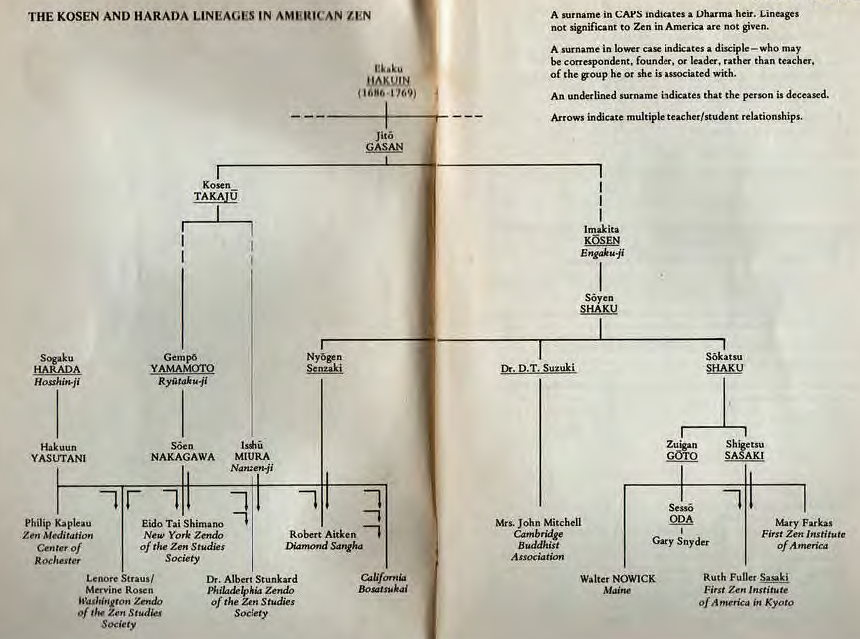
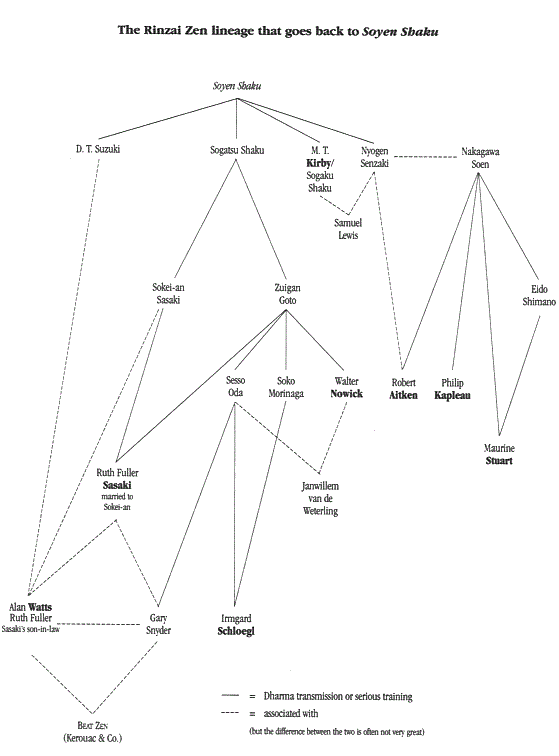
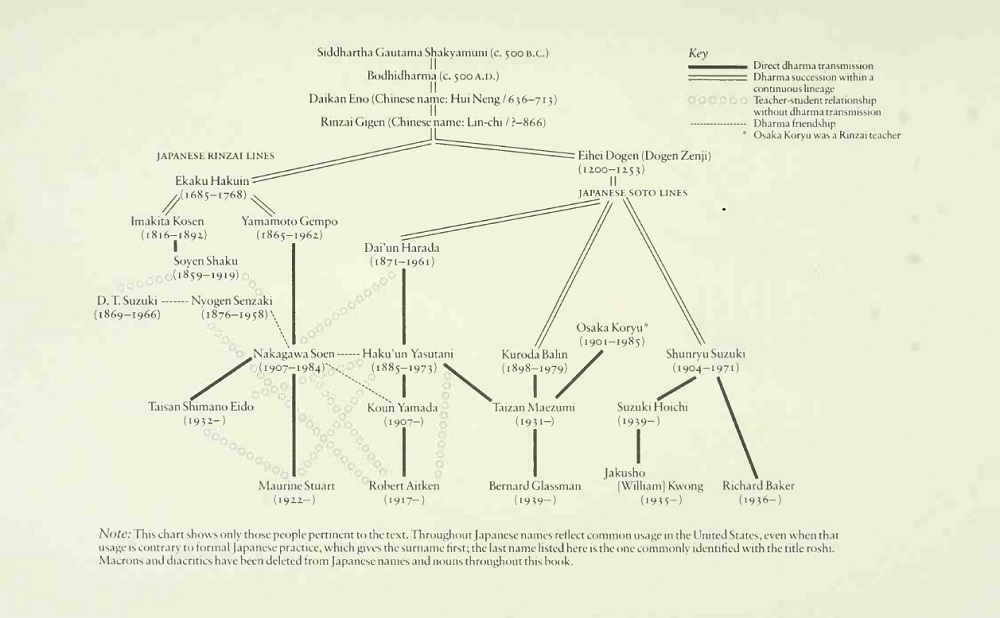

Korean Lineage Charts of the Zen Ancestors